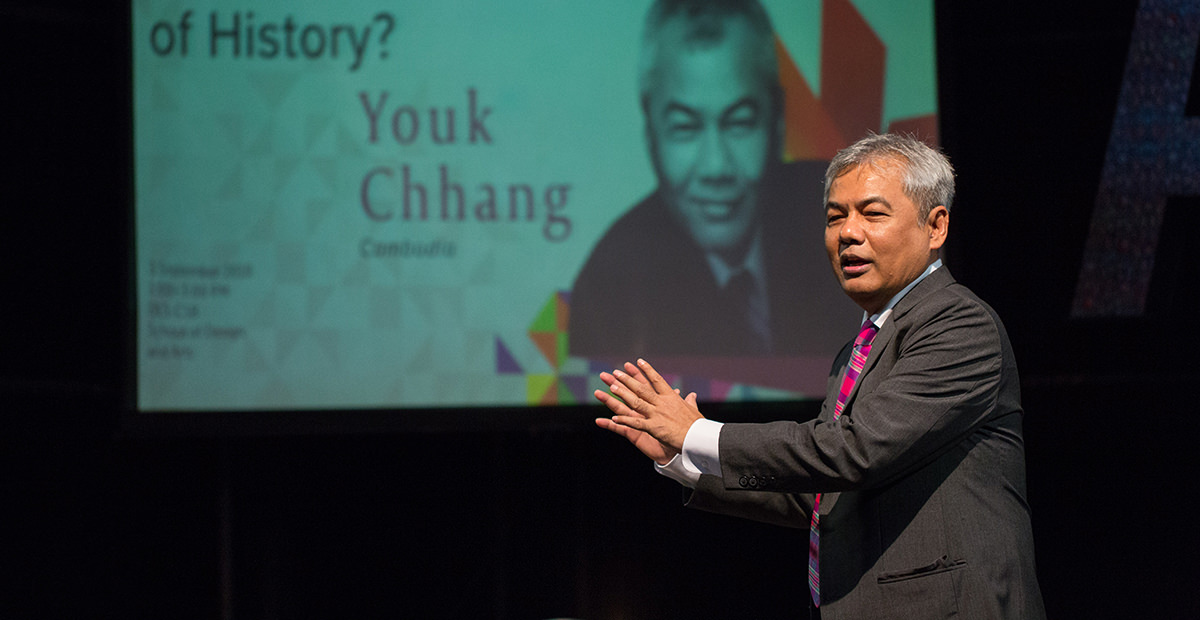This is Part 4 of a four-part series. Read Youk Chhang, Part I: The Long Journey to Asia’s Most Respected Award, Youk Chhang, Part 2: The Khmer Rouge Nightmare and Youk Chhang, Part 3: The Long Trek to an Uncertain Future.
When he arrived in Dallas, Texas, in 1986 the training he had received at the Philippines refugee camp training enabled Mr. Chhang to get a job at a mini-blind company within a week. By the end of the 1980s, he was studying political science at the University of Texas at Dallas and volunteering for grassroots programs that were researching the Khmer Rouge regime and genocide. Several of these were supported through private and U.S. government funding.
At first, the general public’s reaction to the stories told by Cambodian survivors puzzled him. To most Americans, the tales all seemed the same: Victims of the genocide had been starved, made to perform forced labor, and lost family and friends.
He soon realized that specific facts and numbers were necessary to make the public fully aware of the extent of the Khmer Rouge’s crimes. So he decided to devote himself to research.
In the course of his volunteer work and university studies, Mr. Chhang was put in contact with Ben Kiernan, a Yale University professor who had researched the Pol Pot regime since the early 1980s and authored several books on the subject.
Following the signing of the Paris Peace Agreement in 1991, the 1993 national election overseen by the United Nations, and the U.S. adoption of the Cambodian Genocide Justice Act in 1994, Mr. Chhang returned to the country in 1993 to head the Cambodian Genocide Program—now DC-Cam. The U.S. State Department had provided grants to Yale to create the Cambodian Genocide Program with Mr. Kiernan as its founding director and Mr. Chhang as its program officer in Cambodia. In 1997, DC-Cam would become a non-governmental organization with Mr. Chhang as executive director.
With the assistance of international volunteers and interns, the DC-Cam staff has researched and documented a wide range of Khmer Rouge crimes including the policy of forced labor and worker starvation that led to the death of more than 2 million people, the systematic killing of the Cham (Muslim) minority, and the regime’s numerous extermination prisons. This work has involved collecting witness testimonies and identifying mass graves.
In addition to building an extensive archival fond, DC-Cam has published several books based on its findings and also developed a textbook to teach children in Cambodia’s public schools about the Khmer Rouge regime.
When the Extraordinary Chambers in the Courts of Cambodia was established to prosecute the Khmer Rouge’s former leaders—through an agreement between the United Nations and Cambodia that entered into force in 2005—DC-Cam subsequently provided the tribunal with 500,000 copies of documents from its archives. It also funded the court’s acquisition of 650 books, 1,955 CDs and DVDs of films and photos, and 524 microfilm reels.
Among other projects, DC-CAM has set up the Anlong Veng Peace Center for “memory, reconciliation, and peace building” in the Khmer Rouge’s last stronghold of Anlong Veng District. And, in addition to planning to make its archives available online by 2021 and helping to establish a National Historical Commission on Genocide Prevention in Cambodia, DC-Cam aims to create a permanent center—the Sleuk Rith Institute—in Phnom Penh.
Mr. Chhang believes that the work of exposing the actions of genocidal regimes must persist. “Since [the genocide in] Armenia in 1905, genocides have continued, because somehow we declared victory when a crime ended at the tribunal. And that’s wrong.
“We should have learned that the crime never ends at the tribunal…because the crime is committed by human beings. Without a permanent center with researchers and educators conducting work against these atrocities and continuing to educate the public, they shall be repeated,” he said.
Since there is no permanent institution in the region to study and educate young Asians on genocide and human rights, the center could serve that purpose, Mr. Chhang said.
As part of his stand against impunity in Cambodia and elsewhere, Mr. Chhang was member of the eminent-persons group who helped found the Institute for International Criminal Investigations in The Hague in 1993. He was named one of TIME magazine’s “60 Asian heroes” in 2006 and one of the “TIME 100” most influential people in the world in 2007.
Of his family, Mr. Chhang’s father and two brothers died prior to 1975. During the Khmer Rouge regime, two of his sisters died and three survived. One now lives in the U.S., the others live in Cambodia.
Looking back on his life and the moments when he came close to being killed between 1975 and 1985, Mr. Chhang is convinced he survived because he believed in the dream his mother, Keo Nann, had had about his life.
“My mother told me that when she was pregnant…she had a dream that I was lost in the jungle and she was crying looking for me… And she saw me sitting on a mountain with my legs crossed looking to the east.
“When we were separated, she was prepared…She knew that if we were apart, I could become somebody,” he said.
So when Mr. Chhang crossed the barbed wire at the Thai-Cambodian border, seeing the cadavers of those who had not made it, he knew that he would not only survive but that he would make something of his life.
His mother, who never left Cambodia, is now 92 years old.




